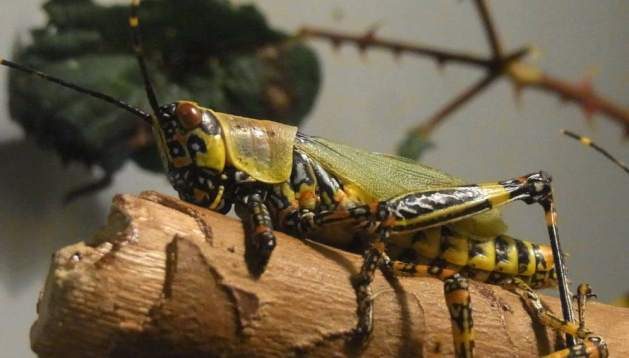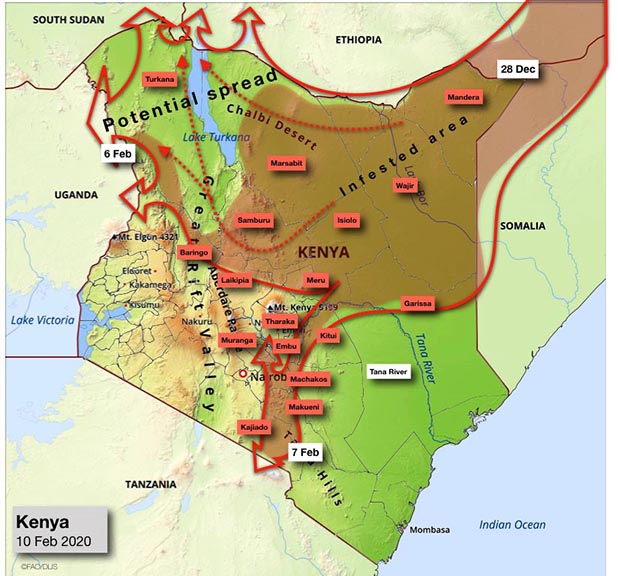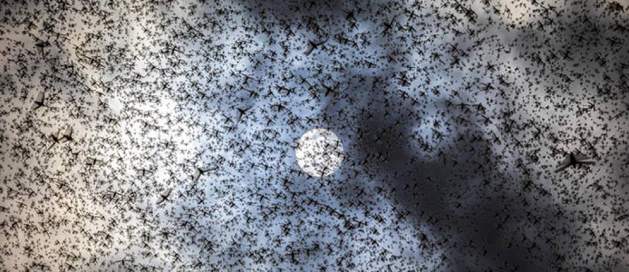Desert Locusts Invade East Africa

NAIROBI, Feb 14 (IPS) - Widespread hatching and movement of destructive desert locusts will turn into a full-blown crisis in the coming weeks in East Africa and neighbouring countries, the UN Food and Agriculture Organization warns.
"Breeding continues in the Horn of Africa, which will cause locusts to increase further in Ethiopia, Somalia and Kenya with new swarms forming in March and April," explains the FAO in a forecast.
The desert locusts have destroyed 70,000 hectares of farmland in Ethiopia and Somalia, threatening food security and livelihoods in both countries. According to the FAO, locust swarms of one square kilometer can eat the same amount of food in one day as about 35,000 people.
This is the worst desert locust invasion Kenya has had in 70 years, while Ethiopia and Somalia experienced an invasion of this magnitude 25 years ago, the FAO says.
The region experienced abnormally heavy rains between October and December, with flooding in regions that are normally semi-arid, creating conditions that are favourable for locust breeding.

"Locust swarms have started laying eggs and another generation of breeding will increase locust numbers," says Keith Cressman, a senior locust forecasting officer at the FAO. "Urgent efforts must be made to stop them from increasing to protect the livelihoods of farmers and livestock holders."
Stephen Njoka, the director-general of Desert Locust Control Organisation for Eastern Africa, tells SciDev.Net: "Climate change could be behind this invasion, for example the current rains in Kenya are very unusual, making vegetation available to the pests and creating suitable egg laying sites in the soil."
The Horn of Africa, made up of Djibouti, Eritrea, Ethiopia and Somalia, has about 115 million people. Because locusts have been found to be nutritious by some communities and cultures in the region, eating them may be a mild measure of control given the overwhelming numbers of the insects, Njoka suggests.
Njoka says that aerial and ground spraying with safe pesticides are the best ways to control locust invasion. The FAO says US$70 million is needed to support rapid control operations, such as spraying with insecticides.

But Daniel Otaye argues that the use of pesticides in the control of locusts is a source of concern, as pesticides might have devastating effects on other beneficial insects such as bees, green lacewings, and dragonflies, which contribute to ecosystem health.
Otaye, an associate professor and chairman in the Department of Biological Sciences, Egerton University in Kenya, says: "The invasion poses disastrous effects on the East African region that is still smarting from insecurity, droughts and aggressive floods."
According to Otaye, the insects can devour fields of crops, such as maize and sorghum, and ravage pastures meant for livestock. He tells SciDev.Net that if the situation is left unchecked, the region might need additional food aid because of the anticipated crop and forage losses.
This story was originally published by SciDev.Net
© Inter Press Service (2020) — All Rights Reserved. Original source: Inter Press Service
 Global Issues
Global Issues